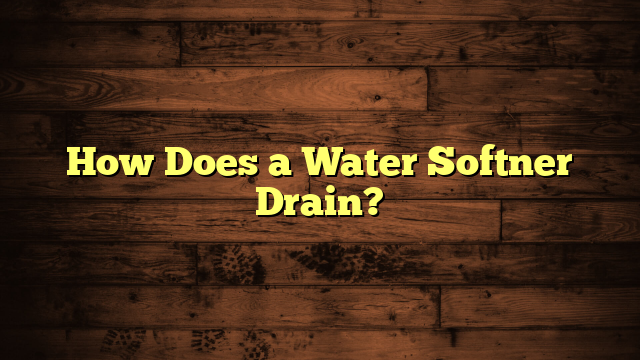How Does a Water Softner Drain?
A water softener drains through a dedicated line, removes impurities, and maintains efficiency. During the regeneration cycle, the system backwashes to eliminate dirt, exchanges ions to soften water, and rinses away brine. This sequence is crucial for ensuring the softener operates smoothly, yet many overlook how fundamental proper drainage is to the entire process. You might be surprised by the complexities involved and the common issues that can arise if drainage isn't handled correctly. Understanding these elements can greatly influence your water quality and system longevity.
Key Takeaways
- A water softener drains wastewater during the regeneration cycle to remove impurities and excess brine from the system.
- The drainage process involves gravity assisting in guiding wastewater away through properly installed drain lines.
- Check valves in the drainage system prevent backflow, ensuring efficient removal of waste materials.
- Clogged drain lines or malfunctioning valves can disrupt drainage, leading to potential system inefficiencies and malfunctions.
- Regular maintenance, including inspections and cleanings, is essential to keep the drainage system functioning properly.
Understanding Water Softener Functionality
A water softener is like a filter for your home's water system, designed to reduce hard minerals such as calcium and magnesium. These minerals contribute to water hardness, causing issues like scale buildup in pipes and appliances.
When you install a water softener, it uses softening agents, typically sodium ions, to replace the hard minerals in your water. As water flows through the softener, it passes over resin beads coated with these softening agents. The calcium and magnesium adhere to the beads while the sodium ions are released into the water, effectively softening it.
The result is water that feels smoother and helps extend the life of your plumbing and appliances. You might notice the benefits immediately—your soap lathers better, your skin feels softer, and you'll likely see fewer mineral deposits around faucets and fixtures.
Understanding how your water softener functions is essential to maintaining its effectiveness and ensuring you enjoy all these advantages. Regular maintenance, such as replenishing the softening agents, is key to keeping your system running smoothly, ensuring you continue enjoying the benefits of softened water.
The Regeneration Cycle
The regeneration cycle is an essential process that keeps your water softener operating effectively. During this cycle, the unit cleans itself, guaranteeing it continues to remove hardness minerals through ion exchange. You'll notice this process happens automatically based on your water usage or set schedule.
Here's a brief overview of the regeneration process:
| Step | Description |
|---|---|
| 1. Backwash | This step flushes out dirt and sediment. |
| 2. Brine Draw | The softener draws brine solution, exchanging sodium for hardness ions. |
| 3. Rinse | Finally, the system rinses the resin bed to remove excess brine. |
In this regeneration process, the resin beads are saturated with sodium ions, which replace the calcium and magnesium ions that cause hardness in your water. Once the cycle completes, your water softener can efficiently reduce hardness levels again. Understanding this cycle helps you appreciate how your system maintains soft water, ultimately extending the life of your plumbing and appliances. Regular regeneration guarantees you enjoy the benefits of soft water without interruptions.
How Drainage Works
Understanding how drainage works is vital for maintaining your water softener's efficiency. Proper drainage guarantees that the system can effectively remove minerals and impurities during the regeneration cycle.
Let's break down the key aspects of drainage systems that facilitate water flow:
- Drain Connection: Your water softener connects to a drain line, allowing waste water to exit the system. This connection is essential for removing brine and other byproducts.
- Gravity Assistance: Many systems rely on gravity to help guide water away. This guarantees that waste water flows smoothly, preventing clogs and backups.
- Check Valve Function: A check valve is often included in the drainage setup to prevent backflow. This keeps your water softener running efficiently and protects it from potential damage.
Components Involved in Draining
Key components play an essential role in guaranteeing effective drainage for your water softener. The drain valve is one of the most important parts involved in this process. When your water softener goes through its regeneration cycle, the drain valve opens, allowing the wastewater to exit the system. This valve needs to function properly to prevent any backups or leaks, guaranteeing a smooth drainage process.
Another significant component is the brine tank. During regeneration, the brine tank fills with a saltwater solution, which is necessary for cleaning the resin beads inside your water softener. Once the regeneration cycle is complete, the brine tank needs to drain efficiently. The drain valve will open at this point, flushing out the spent brine solution to prevent any buildup.
Together, these components guarantee that your water softener operates effectively. Regularly checking the drain valve and maintaining the brine tank can help you avoid potential issues down the line.
Common Drainage Issues
Even with well-functioning components like the drain valve and brine tank, drainage issues can still arise in your water softener.
These problems can affect your system's efficiency and ultimately your water quality. Here are some common drainage issues you might encounter:
- Clogged Drain Lines: Debris or mineral buildup can obstruct the drain line, preventing proper water flow. Regularly check and clean these lines to guarantee smooth drainage.
- Malfunctioning Drain Valve: If the drain valve fails, it can lead to leaks or insufficient drainage during regeneration cycles. Inspect the valve periodically to catch any issues early.
- Brine Tank Overflows: An overflowing brine tank can occur due to a malfunctioning float switch or improper salt levels. Monitor your brine tank regularly to avoid potential water damage.
Understanding these common drainage issues can help you implement effective drainage solutions.
By taking proactive measures, you can maintain your water softener's performance and guarantee consistent water quality in your home.
Regular maintenance is key to preventing these problems and keeping your system running smoothly.
Importance of Proper Drainage
Proper drainage in your water softener is essential for maintaining its efficiency and prolonging its lifespan. When the drainage system functions correctly, you not only guarantee consistent water quality but also promote plumbing efficiency. If the system is clogged or improperly set up, you risk damaging your water softener and may even face costly repairs.
Here's a quick breakdown of the importance of proper drainage:
| Aspect | Importance |
|---|---|
| Water Quality | Guarantees softened water is clean and free of contaminants. |
| Plumbing Efficiency | Reduces strain on plumbing, preventing clogs and backups. |
| Longevity | Extends the life of your water softener system. |
| Maintenance Costs | Lowers the chances of expensive repairs due to neglect. |
| User Satisfaction | Improves overall satisfaction with water service. |
Maintenance Tips for Drainage
How can you guarantee your water softener's drainage system stays in top shape? Regular drainage maintenance is vital for ensuring ideal water quality in your home.
Here are three essential tips to keep your drainage system running smoothly:
- Inspect the Drain Line: Periodically check the drain line for clogs or kinks. A blocked line can lead to backflow or inefficient functioning of your water softener.
- Clean the Brine Tank: At least once a year, clean the brine tank. Residual salt can create a buildup that affects drainage and overall efficiency.
- Monitor Water Levels: Keep an eye on the water levels in your softener. If you notice any irregularities, it could indicate issues with the drainage system that need immediate attention.
Troubleshooting Drainage Problems
Maintaining your water softener's drainage system is just the beginning; knowing how to troubleshoot any issues that arise is equally important.
When you notice your water softener isn't draining properly, your first step is to check the drain hose. Verify it's not kinked or blocked, as this is a common culprit. If you spot any clogs, try using a wet/dry vacuum to clear them out.
Next, inspect the drain valve. If it's stuck, you might need to replace it to restore proper flow.
In some cases, your softener's settings could be off, so double-check to verify it's programmed correctly for your water usage. You might also want to examine the brine tank for any salt bridges that could impede drainage.
For persistent issues, consider other drainage solutions, such as rerouting the drain line or installing a sump pump.
Frequently Asked Questions
Can a Water Softener Drain Into a Sump Pump?
You can drain a water softener into a sump pump, but verify it meets local regulations. It's crucial to check if your sump pump can handle the additional water without affecting its performance.
How Often Should a Water Softener Drain?
Imagine you're filling your bathtub; the water softener should drain every two to four weeks, depending on your water usage. Keeping this maintenance schedule helps guarantee your system runs efficiently and extends its lifespan.
Will a Water Softener Drain Affect My Water Bill?
A water softener drain can impact your water bill, depending on your water usage. By conducting a cost analysis, you'll see how much the softener affects your overall expenses and if it's worth it.
What Happens if the Drain Line Gets Clogged?
Oh, a clogged drain line? That's just what you need! If it happens, your water softener won't function properly. Regular drain maintenance and clog prevention are essential to keep everything flowing smoothly and avoid headaches.
Can a Water Softener Drain Into a Septic System?
You can drain a water softener into a septic system, but be cautious. Excessive salt can affect septic health and water quality. Regular maintenance guarantees your system functions well and prevents long-term issues.
Conclusion
Fundamentally, a water softener's drainage system is like the unsung hero of your home, quietly ensuring efficiency and longevity. By understanding the regeneration cycle and maintaining proper drainage, you can keep your system running smoothly, like a well-oiled machine. Regular inspections and timely troubleshooting are key to avoiding pesky problems down the line. So, embrace these practices, and your water softener will reward you with soft, sparkling water for years to come.







